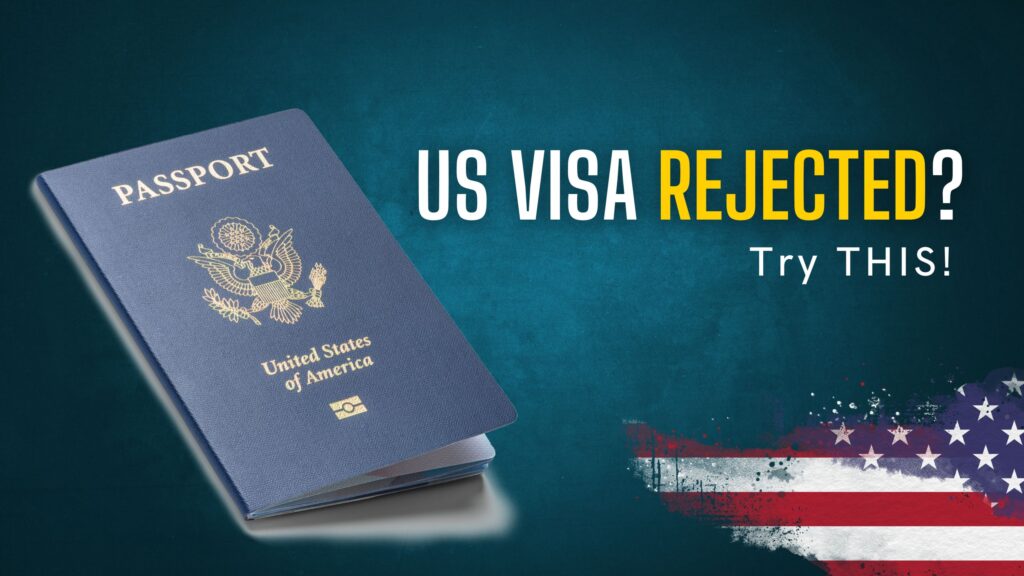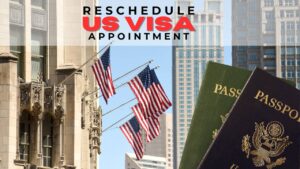Every year, thousands of individuals apply for US visas – whether for tourism, study, work, or family visits. Not all applications are successful. US visa rejections are more common than many expect, and they can happen for a variety of reasons, ranging from missing documents to concerns about an applicant’s intent to return home.
Getting a US visa rejection can be disheartening, but it doesn’t mean the end of your journey. Many applicants successfully reapply and get approved – if they address the reasons for refusal properly. We’ll walk you through how to reapply for a US visa after rejection, including important steps like filling out a new DS-160 form, repaying the visa fee, and attending a fresh interview.
The key is to demonstrate significant changes in your situation since the last application and ensure your answers are accurate, consistent, and backed by proper documentation. Previous visa was denied under Section 214(b) or due to missing paperwork, this guide will help you understand how to prepare a stronger, more convincing application the second time around.
Common Reasons for US Visa Rejection
Getting your US visa rejected can feel upsetting and confusing. But don’t worry – many people face this, and you can still US visa reapply after rejection. Key is to know why it was denied and fix those issues before you apply again. The common reasons for rejection will help you prepare better and improve your chances of getting approved next time. Some of the main reasons why a US visa might get rejected:
- Section 214(b) – Failure to Show Strong Ties to Home Country: Applicants must convince the visa officer that they have compelling reasons (job, family, property, etc.) to return home. Failure to do so often leads to rejection under Section 214(b).
- Incomplete or Incorrect Information on DS-160: Providing inaccurate or incomplete details on the DS-160 form can result in immediate denial. This form is crucial as it determines the first impression during visa processing.
- Financial Ineligibility: Insufficient proof of funds or financial instability may cause rejection. Applicants must demonstrate they can afford the trip without working illegally in the U.S.
- Lack of Travel History or Purpose Clarity: Having no prior international travel experience or providing vague reasons for visiting the U.S. can raise doubts about the applicant’s intent.
- Prior Immigration Violations or Overstay: History of overstaying a visa or violating U.S. immigration laws significantly lowers the chance of future visa approval.
How to Reapply After a US Visa Rejection?
Reapplying after a US visa rejection is possible if you address the reasons for denial. Strengthen your application with updated documents, show changed circumstances, and prepare confidently. There’s no wait time, but improvements are essential.
Yes – But Only When Circumstances Have Changed
If your situation has changed since your last application (e.g., a change in financial status, employment, or purpose of travel), you can reapply. However, simply reapplying without any significant change is unlikely to increase your chances.
No Official Waiting Period, But Improvements are Important
There is no set waiting period to reapply after a visa rejection. However, it’s important to address the reasons for the initial refusal and provide additional or stronger documentation to support your application.
When Reapplication is NOT Recommended
If your circumstances remain the same and the reasons for the initial refusal are unlikely to change, it’s not advisable to reapply. Instead, consider improving your situation (e.g., securing a better job or increasing your financial stability) before reapplying.
Step-by-Step Process to Reapply for a US Visa in 2025
eapplying for a US visa can feel challenging, especially after a refusal. But the good news is that many people receive their visas after a second or third try. All you need is the right approach, preparation, and updated information.
If your visa application was denied earlier, don’t lose hope. The US visa system allows you to apply again after making improvements to your application. Must review what went wrong, correct the mistakes, and apply again with stronger documents and more confidence.
Review Your Previous Rejection Letter
After a visa refusal, the US embassy or consulate gives you a rejection letter. This letter is very important. It contains the reason why they refused your visa.
Read the rejection letter carefully. It may mention a section of the US Immigration and Nationality Act, such as:
- Section 214(b): Most common for tourist and student visa denials. It means you didn’t show strong ties to your home country.
- Section 221(g): Means your case is incomplete and needs more documents.
- Section 212(a): Points to a legal issue or ineligibility.
Why is this step important?
Cannot fix the problem if you don’t know what it was. First step is to understand what led to the denial.
What to do next:
- Keep a copy of the rejection letter.
- Highlight the reason mentioned.
- Search online or ask a visa consultant what that section means.
Analyze the Reason for Refusal
Now that you know the reason for the refusal, it’s time to think carefully.
Ask yourself:
- Did I forget to bring important documents?
- Did I answer a question poorly during the interview?
- Did I give wrong or unclear information?
- Did my financial documents look weak?
- Did the visa officer believe I would not return to my home country?
Understanding these points helps you make changes and prepare better.
Example:
If the officer denied your B1/B2 visa because you lacked strong ties to your home country, then next time, you must show proof of family, job, property, or studies that require you to return.
Tips:
- Talk to people who have successfully received a US visa.
- Review your previous DS-160 form and note any errors or weak answers.
- Avoid blaming the officer. Focus on improving your profile.
Gather Updated and Stronger Supporting Documents
One of the main reasons for visa refusal is weak or missing documents. When you apply again, you must give better and updated documents.
What are supporting documents?
These are papers that prove your purpose of visit, financial status, job, family ties, and more. These documents help the visa officer understand your situation.
Which documents should you gather?
For Tourist Visa (B1/B2):
- Updated bank statements (last 6 months)
- Proof of employment (salary slips, offer letter)
- Leave letter from your job
- Property documents (if any)
- Travel plan (flight booking, hotel reservation)
- Family documents (marriage certificate, children’s birth certificate)
For Student Visa (F1):
- I-20 form from the US college/university
- Updated bank balance showing funds for tuition and living expenses
- Scholarship letters (if applicable)
- Proof of academic history (transcripts, degrees)
- SEVIS payment receipt
For Work Visa:
- Job offer letter from a US company
- Proof of qualification
- Previous work experience
- Updated resume
- Company documents
How to make documents stronger?
- Make sure they are recent (no older than 6 months).
- Print on official letterhead.
- Add clear contact details.
- Translate non-English documents to English.
- Include cover letters explaining unclear information.
Fill Out a New DS-160 Form
Every time you apply for a US visa, you must fill out a new DS-160 form. This is the online visa application form.
Where to find it?
Go to the official website: https://ceac.state.gov/
How to fill it?
- Start a new application.
- Select the location where you will apply.
- Save the application ID for future use.
- Answer all questions honestly.
- Upload a recent passport-size photo.
What does it ask?
- Full name, date of birth, passport number
- Travel plans and purpose
- Family and work details
- Educational background
- Security questions
Tips:
- Keep your passport and old DS-160 form beside you.
- Be honest; do not lie.
- Review your form before submitting.
Once submitted, save the confirmation page. You need to bring this to your visa interview.
Pay the Non-Refundable Visa Application Fee Again
Must pay the visa application fee again, even if your last application was refused. This fee is non-refundable.
How much is the fee?
As of 2025, the fee is around:
- $185 for B1/B2, F1, and other non-immigrant visas.
- Check the latest fee on the US embassy website in your country.
How to pay?
- Online via bank transfer, credit card, or payment gateway
- At a bank branch (depending on the country)
- Save the payment receipt
Need this payment proof when scheduling your visa interview.
Schedule a New Visa Interview
After paying the fee, you can book a new appointment for the visa interview.
How to book?
- Visit the US embassy/consulate website in your country
- Create an account or log in
- Select visa type
- Enter your DS-160 confirmation number
- Choose a date and time for the interview
Some countries also allow you to choose a dropbox or interview waiver if you meet certain conditions.
Documents you need for the appointment:
- Valid passport
- DS-160 confirmation page
- Visa fee payment receipt
- Appointment confirmation
- Supporting documents
Important:
You can apply again anytime. There is no waiting period unless stated by the embassy. However, only apply again when you are ready and have improved your case.
Prepare Thoroughly for the Interview
The visa interview is the most important step. Officer will ask you questions to decide if they should approve your visa.
How to prepare?
Practice answering common questions:
- Why do you want to go to the US?
- Who will pay for your trip?
- Do you have family or friends in the US?
- What will you do after returning?
- Why was your visa denied earlier?
Bring the right documents:
- All supporting documents (original and copies)
- Passport and DS-160 form
- Payment and appointment proof
Dress neatly and arrive early:
- Wear formal or smart clothes
- Reach the embassy at least 30 minutes early
During the interview:
- Be calm and polite
- Answer clearly and honestly
- Don’t give too much information unless asked
- Stay confident, even if the officer looks serious
Avoid these mistakes:
- Giving false information
- Arguing with the officer
- Showing nervous behavior
- Not preparing for basic questions
Tips to Strengthen Your Reapplication
- Be Honest and Consistent: Provide accurate information and ensure consistency across all your documents and application forms. Any discrepancies can raise red flags.
- Correct Past Mistakes: Review your previous application carefully. Address and correct any errors or unclear answers from your earlier submission.
- Show Stronger Ties to Your Home Country: Demonstrate compelling reasons for returning home—such as family obligations, a stable job, property ownership, or ongoing education.
- Highlight Improvements in Financial or Employment Status: If your financial situation or job position has improved, include relevant documentation to prove your stronger eligibility.
- Carry a Well-Organized Document File: Present your documents in a neat, logical order. Include a cover sheet or checklist to help the officer navigate your application quickly.
Best Essential Tips for Visa Interviews After Rejection
Facing a visa rejection can be discouraging, but it doesn’t mean the end of your journey. With the right approach, mindset, and preparation, you can significantly improve your chances of success in future interviews. Below, we share decorative yet best practices on what to say in your visa interview after rejection and how to reapply after multiple rejections.
What to Say in Your Visa Interview After Rejection
If your previous visa application was denied, it’s crucial to approach your next interview with clarity, confidence, and honesty. Here’s how to make your case stronger:
Address the Reason for Past Rejection Clearly
Don’t ignore the elephant in the room. Begin by respectfully acknowledging the previous denial. Clearly explain the reason you were given and provide updated, accurate information to counter or clarify it.
Example:
“During my last application, I was denied due to insufficient ties to my home country. Since then, I have secured a permanent job and purchased property, both of which demonstrate my strong intent to return.”
Show Confidence and Honesty
Visa officers are trained to detect insincerity. Speak honestly about your intentions and plans. Confidence does not mean arrogance—it means being sure of your documents, purpose, and answers.
Tip: Sit upright, make eye contact, and stay calm. These non-verbal cues can make a big difference.
Avoid Memorized or Vague Answers
Practice your responses, but do not sound robotic. Visa officers appreciate natural, thoughtful replies. Avoid using generic phrases like “I want to explore opportunities” unless you have solid backing information.
Instead of saying:
“I love the USA.”
Say:
“I am attending a certified academic program in cybersecurity that is not available in my home country, and it aligns with my career goals.”
Be Ready to Explain What Has Changed Since Last Time
Interview should reflect growth. Whether it’s a change in your financial condition, employment status, education, or purpose of visit – explain how your application has improved since the last attempt.
Make it real:
“Previously, my financial documents were incomplete. This time, I have submitted updated income tax returns, bank statements, and a letter from my employer confirming paid leave for my travel dates.”
Reapplying After Multiple Rejections
Being denied more than once can be frustrating, but it’s important to reflect, re-strategize, and move forward wisely. How to handle multiple rejections:
When to Wait and Reassess
If you’ve faced multiple denials, don’t rush to reapply. Instead, take time to review each reason of rejection and improve your application.
Checklist before reapplying:
- Have your circumstances changed?
- Are your documents in order and consistent?
- Can you convincingly prove ties to your home country?
Reapplying with the same flaws will only lead to further rejection.
Consider Other Visa Categories
Sometimes, the issue may not be you—it may be the visa category you’re applying under. Consider if another visa type better fits your travel or study plans.
Example:
If your tourist visa is repeatedly rejected due to suspicion of immigration intent, consider whether a student or work visa might be more appropriate for your situation.
Help from Immigration Experts or Legal Advisors
Professional immigration consultants and legal advisors can provide valuable insights that are not obvious to the average applicant. They can help you:
- Identify hidden errors in your previous applications
- Draft more compelling personal statements
- Ensure your documents meet embassy standards
Visa interviews are not just about what’s on paper; they’re about you as an individual. Learning from a rejection and applying strategically can turn the tide in your favor. Be honest, stay confident, and make sure your story reflects genuine intent and readiness. It’s your second attempt or fifth, each interview is a fresh opportunity.
FAQs
Can I reapply for a US visa after being rejected?
Yes, you can reapply for a US visa after a rejection. However, it’s crucial to address the reasons for your previous denial and provide new or additional information that supports your eligibility.
How long do I have to wait to reapply for a US visa after rejection?
There is no mandatory waiting period. Reapply immediately after a rejection. It’s advisable to wait until you can correct or improve upon the issues that led to the denial.
Do I need to pay the visa fee again if my US visa was rejected?
Yes, the visa application fee (MRV fee) is non-refundable and non-transferable. If you reapply, you must pay the full fee again.
What are common reasons for US visa rejection?
Common reasons include:
- Section 214(b): Failure to prove strong ties to home country.
- Incomplete documentation.
- Inadequate financial proof.
- Previous immigration violations.
- Misrepresentation or fraud.
Can I apply for the same type of US visa after rejection?
Yes, you can reapply for the same visa category. Ensure you have stronger documentation or updated circumstances that justify a new decision.
How many times can I reapply for a US visa after rejection?
There is no limit to the number of times you can reapply. But frequent reapplications without addressing the core reasons for denial may reduce your chances.
Can I reapply for a different type of US visa after rejection?
Yes, you can apply for a different visa category if your eligibility has changed or if another visa type is more appropriate for your purpose.
Should I seek professional help after a US visa rejection?
It is often beneficial to consult a visa expert or immigration lawyer, especially if the denial was due to complex issues like inadmissibility, documentation errors, or past overstays.






